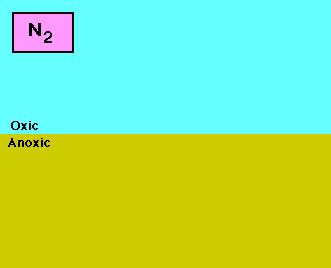Animation of the Nitrogen Cycle
Copyright 1998, Thomas M. Terry, The University of Conn.

The nitrogen cycle has many links. The series of interconversions shown here is only one possible example of how nitrogen might move through the cycle. Stages include the following:
- Nitrogen Fixation: converts gaseous nitrogen (N2) into ammonia (NH3). Certain bacterial species, both aerobic and anaerobic, carry out this conversion.
- Nitrification: only certain bacteria, the nitrifying bacteria, can use NH3 as an energy source. The reaction occurs in two steps:
- Nitrosomonas bacteria convert ammonia (NH3) to nitrite (NO2-)
- Nitrobacter bacteria convert nitrite (NO2-) to nitrate (NO3-)
- Denitrification: bacteria that can respire anaerobically will convert nitrate (NO3-) to nitrite (NO2-). Note that nitrate is now serving as an electron acceptor. Some anaerobic respirers can also use nitrite (NO2-), converting it further into nitrous oxide (NO), nitrogen dioxide (N2O), and ultimately nitrogen gas (N2).
- Assimilation: ammonia can be directly assimilated into organic compounds inside cells, producing amino groups (-NH2).
- Excretion: during excretion, fermentation, and other catabolic processes, excess amino groups (-NH2) are released, ultimately producing ammonia (NH3).
- Assimilatory Nitrate Reduction: since nitrate (NO3-) is far more common than ammonia, many organisms can only acquire nitrogen in the form of nitrate. They must reduce nitrate to form the amino groups needed for metabolism. This process, which superficially resembles nitrate reduction by anaerobic respiration, is entirely different.
